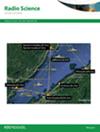A cryogenic wideband (2.5–14 GHz) receiver system for the Arecibo Observatory 12 m telescope
IF 1.6
4区 地球科学
Q3 ASTRONOMY & ASTROPHYSICS
引用次数: 0
Abstract
In this paper we present details of the construction of a wideband, cryogenic receiver and its successful commissioning on the Arecibo Observatory 12m telescope. The cryogenic receiver works in the 2.5–14 GHz frequency range. We upgraded the current narrow band, room temperature receivers of the telescope with the new wideband receiver. The current receiver is built around a Quadruple-Ridged Flared Horn (QRFH) developed by Akgiray et al. (2013, https://doi.org/10.1109/tap.2012.2229953). To mitigate strong radio frequency interference (RFI) below 2.7 GHz, we installed a highpass filter before the first stage low noise amplifier (LNA). The QRFH, highpass filter, noise coupler and LNA are located inside a cryostat and are cooled to 15 K. The measured receiver temperature is 25 K (median value) over 2.5–14 GHz. The system temperature measured at zenith is about 40 K near 3.1 and 8.6 GHz and the zenith antenna gains are 0.025 and 0.018 K/Jy at the two frequencies respectively. We recommend the following improvements to the telescope system: (a) Upgrade the highpass filter to achieve better RFI rejection near 2.5 GHz; (b) Improve aperture efficiency at 8.6 GHz; (c) Upgrade the intermediate frequency system to increase the upper frequency of operation from 12 to 14 GHz.阿雷西博天文台 12 米望远镜低温宽带(2.5-14 千兆赫)接收器系统
本文详细介绍了宽带低温接收机的构造及其在阿雷西博天文台 12 米望远镜上的成功试运行。低温接收机的工作频率范围为 2.5-14 GHz。我们用新的宽带接收机升级了望远镜目前的窄带室温接收机。目前的接收器是围绕 Akgiray 等人开发的四倍褶皱喇叭(QRFH)(2013 年,https://doi.org/10.1109/tap.2012.2229953)制造的。为了减轻 2.7 GHz 以下的强射频干扰(RFI),我们在第一级低噪声放大器(LNA)之前安装了一个高通滤波器。QRFH、高通滤波器、噪声耦合器和 LNA 位于低温恒温器内,冷却至 15 K。天顶测得的系统温度在 3.1 和 8.6 GHz 附近约为 40 K,两个频率的天顶天线增益分别为 0.025 和 0.018 K/Jy。我们建议对望远镜系统进行以下改进:(a) 升级高通滤波器,以在 2.5 千兆赫附近实现更好的射频干扰抑制;(b) 提高 8.6 千兆赫的孔径效率;(c) 升级中频系统,将最高工作频率从 12 千兆赫提高到 14 千兆赫。
本文章由计算机程序翻译,如有差异,请以英文原文为准。
求助全文
约1分钟内获得全文
求助全文
来源期刊

Radio Science
工程技术-地球化学与地球物理
CiteScore
3.30
自引率
12.50%
发文量
112
审稿时长
1 months
期刊介绍:
Radio Science (RDS) publishes original scientific contributions on radio-frequency electromagnetic-propagation and its applications. Contributions covering measurement, modelling, prediction and forecasting techniques pertinent to fields and waves - including antennas, signals and systems, the terrestrial and space environment and radio propagation problems in radio astronomy - are welcome. Contributions may address propagation through, interaction with, and remote sensing of structures, geophysical media, plasmas, and materials, as well as the application of radio frequency electromagnetic techniques to remote sensing of the Earth and other bodies in the solar system.
 求助内容:
求助内容: 应助结果提醒方式:
应助结果提醒方式:


